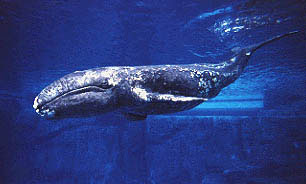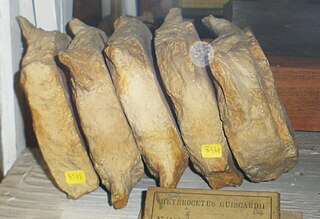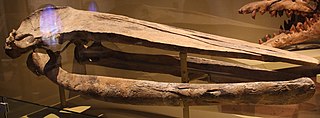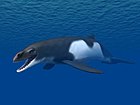
Eschrichtiidae or the gray whales is a family of baleen whale with a single extant species, the gray whale, as well as four described fossil genera: Archaeschrichtius (Miocene), Glaucobalaena and Eschrichtioides (Pliocene) from Italy, and Gricetoides from the Pliocene of North Carolina. Some phylogenetic studies have found this family to be invalid, with its members nesting inside of the clade Balaenopteridae. The names of the extant genus and the family honours Danish zoologist Daniel Eschricht.

Neobalaenidae is a family of baleen whales including the extant pygmy right whale. Although traditionally considered related to balaenids, recent studies by Fordyce and Marx (2013) and Ludovic Dutoit and colleagues (2023) have recovered the living pygmy right whale as a member of Cetotheriidae, making it the only extant cetotheriid. Not all authors agree with this placement.

Cetotherium is an extinct genus of baleen whales from the family Cetotheriidae.

Cetotheriidae is a family of baleen whales. The family is known to have existed from the Late Oligocene to the Early Pleistocene before going extinct. Although some phylogenetic studies conducted by Fordyce & Marx 2013 recovered the living pygmy right whale as a member of Cetotheriidae, making the pygmy right whale the only living cetotheriid, other authors either dispute this placement or recover Neobalaenidae as a sister group to Cetotheriidae.

Parietobalaena is an extinct genus of baleen whale, belonging to the family Pelocetidae. Fossils are found in Miocene-aged marine strata in North America, Europe, Australia, and Japan, including the Temblor and Itahashi formations. Based on previous estimates of juvenile specimens, Tsai (2017) suggested a body size of 12-15 m for P. yamaokai, akin to that of the gray whale.
Mesocetus is an extinct genus of baleen whale from the Miocene of Europe and North America.

Scaldicetus is an extinct genus of highly predatory macroraptorial sperm whale. Although widely used for a number of extinct physeterids with primitive dental morphology consisting of enameled teeth, Scaldicetus as generally recognized appears to be a wastebasket taxon filled with more-or-less unrelated primitive sperm whales.

Heterocetus is a dubious genus of extinct cetacean.

Titanocetus is a genus of extinct cetaceans closely related to the family Cetotheriidae.

Archaebalaenoptera is a genus of extinct rorqual known from late Miocene to Pliocene-age marine deposits of the Netherlands, Northern Italy, and Peru.
Plesiocetus is a genus of extinct rorquals found worldwide. It has had a chequered taxonomic history, having served as a wastebasket genus for a handful of mysticete species.

Eschrichtioides is an extinct genus of baleen whale known from the early Pliocene of Northern Italy. Its type species, E. gastaldii, had a complex taxonomic history, starting as a cetothere, then as an extinct member of Balaenoptera, before being finally recognized as a relative of the gray whale.

Cetotheriopsis is a genus of extinct cetaceans of the family Cetotheriopsidae.

Idiocetus is a genus of extinct cetaceans of the family Balaenidae.

Aglaocetus is a genus of extinct baleen whales known from the Miocene of Patagonia, the US Eastern Seaboard, Japan and the Low Countries. It was once considered a member of Cetotheriidae along with many other putative cetotheres, but was recently recognized as representing a distinct family from true Cetotheriidae.
Nannocetus is an extinct baleen whale belonging to the family Cetotheriidae.
Mauicetus is a genus of extinct baleen whale from the Late Oligocene of New Zealand.
Otradnocetus is an extinct genus of baleen whale from the middle Miocene of the Russian Caucasus.

Atlanticetus is a genus of extinct baleen whales known from the Early Miocene of Italy and the US Eastern Seaboard.
















